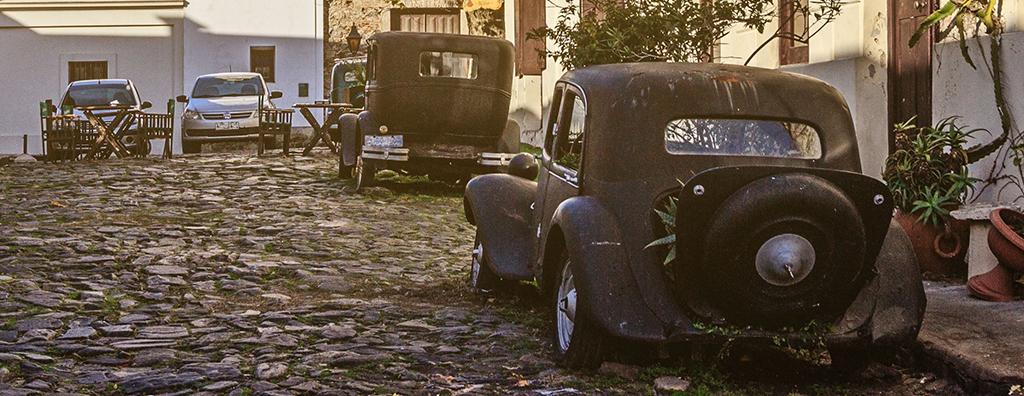
Uruguay Travel Guide
Uruguay is tucked away in South America’s sweet spot, hidden beneath the elephantine shadows of this continent’s giants. Yet despite its size, this dark horse is not so easily dismissed. Uruguay is epic in its diversions, extraordinary in its chance encounters, extending beyond its beaches and its UNESCO Heritage Sites. Don’t believe us? Find out for yourself.
The Highlights


The Basics
The Location
Uruguay is a country on the southeast coast of South America bordering Argentina and Brazil. From New York, a flight is 14h 40m with a stopover. From London, a flight is 16h 20m with a stopover.
Capital City
Montevideo, the capital, is situated on Uruguay's southern coast. The eclectic metropolitan area is home to half the country's population.
Main Airport
Montevideo's Carrasco International Airport is the main hub for domestic and international arrivals and departures. It is located in the suburb of Carrasco, 19 kilometres from downtown Montevideo
- Code
- MVD
- Closest City
- Montevideo
Language Spoken
The official language is Spanish. English is limited to tourist spots, some restaurants and some highly educated residents of Montevideo and Punta del Este.
Currency
Uruguay uses the Uruguayan Peso. The currency code is UYU. ATMs and credit cards are widely available in Uruguay.
Visas
For Australian, Canadian, UK and US citizens, no prior visa is required and will be issued upon arrival. A 90-day tourist card received upon entry can be extended another 90 days in Uruguay in most cases.
Electricity
Uruguay uses 230V/50hz as well as the two round pin C and F, angled three straight pins I, and three round pin L plugs. You may need a surge adaptor and converter so find out before your trip.
Vaccinations
Typhoid, Hepatitis A, Hepatitis B and Rabies vaccinations are advised. Consult your doctor for your itinerary 4 to 6 weeks before you depart.
Emergency Calls
All emergency services such as police, ambulance or fire can be reached by calling 911 in Montevideo and 02-911 outside of the city. You can also reach them individually by calling 109 for police, 105 for ambulance services and 104 for fire services.
When to Visit

Uruguay Tours

Visit Responsibly
Travelling responsibly means respecting the communities, culture and environment of the places you visit. Keep these tips in mind when travelling to Uruguay:
Go green. Be environmentally conscious on the road by taking short showers; turning off the lights in your hotel room when you leave; and resisting the urge to collect any plants, seashells, or other natural flora.
Respect cultural differences. Before travelling, read about the local culture and customs – even just knowing the dress code and a few basic phrases in the local language will go a long way.
Support local businesses. Enjoy a more authentic experience and directly support the local economy by travelling with a local guide, eating in local restaurants, buying from local artisans, and staying in locally-owned and operated accommodations.
Wherever possible, avoid single-use plastics. Pack reusable items such as your own shopping bags, utensils, a water bottle, and a straw. These items are typically lightweight and compact, and will greatly reduce your consumption of plastics.
Be conscious of overtourism. Opt to visit the lesser-known regions of Uruguay or travel outside the peak season – you'll likely even get a better deal and won't have all the crowds!Sustainable Tourism in Uruguay
Sustainable Practices
For the past five years, renewable energy sources have been generating over 95% of Uruguay’s electricity. Wind farms, hydroelectric plants, and fields of solar panels can be found throughout the beautiful Uruguayan landscape. As of 2019, Uruguay was also ranked as high as number three in the world in terms of wind power generation.
Sustainable Wine
Many Uruguayan winemakers are now focusing on sustainable viticulture. In 2019, a three-year sustainability program and certification was established for wine producers. Developed together with these producers, the sustainability qualification focuses on sustainable and ecological production of high-quality wine grapes. With this new certification, the use of many agrochemicals will be eliminated.
Ecotourism in Uruguay
Due to its numerous nature reserves, Uruguay is a haven for ecotourism. Here, visitors have the choice of exploring caves, hiking, camping, or relaxing by one of the many secluded lakes. In addition, Uruguay is home to many species of breeding and migratory birds and is considered a bird watcher's paradise.
FAQs about Uruguay
Do you tip in Uruguay?
The short answer is yes. Typically, you add a tip of 10% at restaurants, reward taxi drivers and parking attendants UY$5-10, and porters UY$1-2 per bag.
What is the internet access like?
The Internet is pretty much found anywhere in Uruguay’s cities and larger towns. Mid to high-end hotels, restaurants, cafes, shopping malls and some buses offer free WiFi.
Is the tap water safe to drink?
Yes. Scotland boasts exceptionally clean water and is safe to drink. Bottled water is readily available.
Can I use my credit cards?
Visa and MasterCard are commonly accepted by big businesses—hotels, restaurants and shops, in particular.
What are the public holidays?
Besides Christmas, New Year’s Day, and the Easter holidays, Uruguay also celebrates Dia de Los Reyes on January 6, Return of the 33 Exiles on April 19, Labour Day on May 1, Battle of Las Piedras on May 18, Artigas’ Birthday on June 19 and Independence Day on August 25.
What are the toilets like?
You might encounter squat toilets in older businesses. However, most have modern facilities of the sit-down kind. Throw your used toilet paper in the rubbish bin.
How do you get around in Uruguay?
Buses are comfortable ways to get from one city or town to another while taxis, local buses and ride-sharing services are great ways to get around the capital.
Is it true that Uruguay is LGTBQ-friendly?
Absolutely! Uruguay is the most welcoming South American destination for LGBTQ travellers. In fact, it was the first Latin American country to legalise same-sex marriage.














